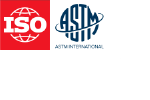Résumé
1.1 This practice covers the preparation, handling, testing, and procedure for using the ethanol-chlorobenzene (ECB) dosimetry system to measure absorbed dose to water when exposed to ionizing radiation. The system consists of a dosimeter and appropriate analytical instrumentation. For simplicity, the system will be referred to as the ECB system. The ECB dosimeter is classified as a type I dosimeter on the basis of the effect of influence quantities. The ECB dosimetry system may be used as a reference standard dosimetry system or as a routine dosimetry system.
1.2 ISO/ASTM 51538 is one of a set of standards that provides recommendations for properly implementing dosimetry in radiation processing, and describes a means of achieving compliance with the requirements of ISO/ASTM Practice 52628 for the ECB system. It is intended to be read in conjunction with ISO/ASTM Practice 52628.
1.3 This practice describes the mercurimetric titration analysis as a standard readout procedure for the ECB dosimeter when used as a reference standard dosimetry system. Other readout methods (spectrophotometric, oscillometric) that are applicable when the ECB system is used as a routine dosimetry system are described in Annex A1 and Annex A2.
1.4 This practice applies only to gamma radiation,
X-radiation/bremsstrahlung, and high energy electrons.
1.5 This practice applies provided the following conditions are satisfied:
1.5.1 The absorbed dose range is between 10 Gy and 2 MGy for gamma radiation and between 10 Gy and 200 kGy for high current electron accelerators (1, 2) (Warning?the boiling point of ethanol chlorobenzene solutions is approximately 80 °C. Ampoules may explode if the temperature during irradiation exceeds the boiling point. This boiling point may be exceeded if an absorbed dose greater than 200 kGy is given in a short period of time.)
1.5.2 The absorbed-dose rate is less than 106 Gy s−1(2).
1.5.3 For radionuclide gamma-ray sources, the initial pho-ton energy is greater than 0.6 MeV. For bremsstrahlung photons, the energy of the electrons used to produce the bremsstrahlung photons is equal to or greater than 2 MeV. For electron beams, the initial electron energy is greater than 8 MeV (3).
NOTE 1 The same response relative to 60Co gamma radiation was obtained in high-power bremsstrahlung irradiation produced bya5MeV electron accelerator (4).
NOTE 2 The lower energy limits are appropriate for a cylindrical dosimeter ampoule of 12-mm diameter. Corrections for dose gradients across the ampoule may be required for electron beams. The ECB system may be used at lower energies by employing thinner (in the beam direction) dosimeters (see ICRU Report 35). The ECB system may also be used at X-ray energies as low as 120 kVp (5). However, in this range of photon energies the effect caused by the ampoule wall is considerable.
NOTE 3 The effects of size and shape of the dosimeter on the response of the dosimeter can adequately be taken into account by performing the appropriate calculations using cavity theory (6).
1.5.4 The irradiation temperature of the dosimeter is within the range from −30 °C to 80 °C.
NOTE 4 The temperature dependence of dosimeter response is known only in this range (see 5.2). For use outside this range, the dosimetry system should be calibrated for the required range of irradiation tempera-tures.
1.6 This standard does not purport to address all of the safety concerns, if any, associated with its use. It is the responsibility of the user of this standard to establish appro-priate safety and health practices and determine the applica-bility of regulatory limitations prior to use. Specific warnings are given in 1.5.1, 9.2 and 10.2.
1.7 This international standard was developed in accor-dance with internationally recognized principles on standard-ization established in the Decision on Principles for the Development of International Standards, Guides and Recom-mendations issued by the World Trade Organization Technical Barriers to Trade (TBT) Committee.
Cycle de vie
-
Précédemment
AnnuléeISO/ASTM 51538:2009
-
Actuellement

